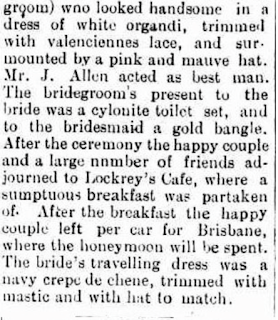
Sydney Mechanics' School of Arts
 Is that a name you are familiar with? If not, you're not alone... after all, it was founded in 1833 as a non profit organisation with the aim of making a difference through learning. It was also known as the Mechanics' Institute and is known as the oldest continuous lending library in Australia.
Is that a name you are familiar with? If not, you're not alone... after all, it was founded in 1833 as a non profit organisation with the aim of making a difference through learning. It was also known as the Mechanics' Institute and is known as the oldest continuous lending library in Australia.
There is a lot more about this particular institute on Wikipedia...
https://en.wikipedia.org/wiki/Sydney_Mechanics%27_School_of_Arts
 It was a great step forward when the first dedicated building was established. Prior to it's inception in Pitt Street, Sydney, in 1837, meetings had been held at various places around the city. There were to be many changes ahead.
It was a great step forward when the first dedicated building was established. Prior to it's inception in Pitt Street, Sydney, in 1837, meetings had been held at various places around the city. There were to be many changes ahead.
From TROVE...
Newcastle Morning Herald and Miners' Advocate (NSW / 1876 - 1954) Thu 3 Feb 1898 Page 7
School of Arts Buildings were built across the country... they varied enormously in size, some started out small and were added to as funds permitted. Around our home town other School of Arts were in Raleigh, Coff's Harbour, Bellingen and Dorrigo, to name just a few..
They were used for so many purposes including town meetings, meetings for numerous organisations, for libraries, for council offices, even for the visiting bank officers. Weddings and all manner of receptions were held in them, as well as dances and balls, flower shows, concerts, travelling shows, e.g. such as Col Joye and Judy Stone, the hypnotist, Ron Rico, Slim Dusty and so many more.
Some were used for showing the early picture shows. There were even boxing bouts in some, including Coffs Harbour.
When we left our small town, in 1960, like many others who were well known in the town, we were given a farewell evening.. a few speeches, some entertainment, including my young brother whistling "Bimbo" while smiling... his party trick, encouraged by Dad's great friend, Stan Morris. Then there was the supper, provided by the community who 'brought a plate'. I don't recall what my parents were presented with as a farewell gift, but I do recall my father and mother being very embarrassed, as they didn't expect it. My Dad's family had been in Urunga since 1927.. his sister lived there still till her passing in 1987.
These are just a few examples of how popular they were, and in many cases still are...
The Raleigh Sun(Bellingen,
NSW/1898-1918) Fri 26 May 1911.
Urunga.
From Our Correspondent
On Saturday last in the School
of Arts the Oddfellows' Minstrel
Troupe, under the conductorship of
Mr. Claude Hefren, played to an ex-
ceptionally large house and was a
complete success. The performers
were as follows Mr. W. Smedley
(centre man), F. Atherton, W. Kay,
R. Wilson, and C. Larsen (corner
men). The above artists caused
considerable amusement which was
well appreciated by the audience.
Mr. M. J. McGrath (Secretary) must
be congratulated on the success of
performed their parts very well in-
qeed, especially R. Wilson and F.
Atherton. Mr. Claude Hefren acted
as conductor and stage, manager. The
concert ended with a very laughable
farce, called "The Telephonograph"
which had the house in fits of laugh-
ter. The proceeds amounted to about
£20. Very creditable to the per
A lucky escape for the Urunga School of Arts
Newcastle Morning Herald and Miners' Advocate (NSW / 1876 - 1954)
Thu 28 Nov 1929 Page 7 URUNGA BLAZE
Coffs Harbour Advocate (NSW / 1907 - 1942; 1946 - 1954) Tue 7 Jun 1949 Page 7
The School of Arts was run by trustees, the group changed over the years but it was always in the good hands of community minded citizens...
In later years, the original School of Arts became the Urunga Museum and was shifted from it's first position to another site.. the large hall that was added many years ago, remains where it was opposite the bottom of the school, across the road from the War Memorial.
Photo courtesy of Lynne Sanders-Braithwaite
Long may the now museum bring back memories to all who love history, especially that of Urunga. For me, it will always be the School of Arts and the memories of the very first library I ever saw will stay with me always.
I would love to hear if your community has a School of Arts and what it is/was used for... Feel free to leave a comment below...































